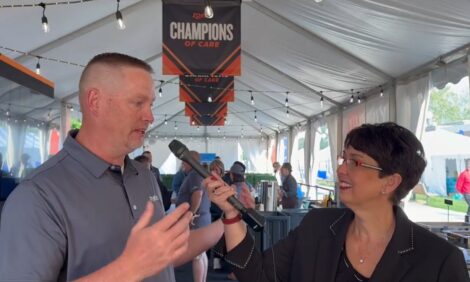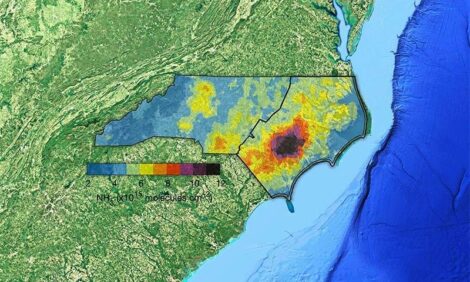



Review of the U.S Hog Market - April 2003
Our Monthly look at the trends in US Hog Market and what effect these may have on future prices - Written by James Mintert, Kansas State University.Hog Prices Below A Year Ago
National base prices reported by USDA
averaged about $47.68 per cwt. (carcass
weight) during the January-March quarter,
7.5% below a year ago.
National net hog
prices (which include carcass premiums and
discounts) averaged approximately $50 per
cwt. during 2003’s first quarter, about 7%
below last year. Similarly, USDA’s
estimated pork cutout value averaged about
$53.79 per cwt. during January-March, 6.9%
below 2002’s.
The year-to-year decline in hog prices means
that pork producers are still losing equity.
According to Iowa State University, farrow-finish
hog operations during January-February
2003 lost an average of $18 per
head marketed. This follows an average loss
per head marketed of $16 during 2002. And
2002 was the third year in the last five that
farrow-finish operations have lost money.
Commercial hog slaughter totalled 24.5
million head during the January-March
quarter 1.3% larger than last year and larger
than forecast, based upon USDA’s December
Hogs and Pigs report inventories. Based
upon the December report, hog slaughter
during the January-March quarter was
expected to fall about 1% below a year ago,
instead of rising above last year.
Last year, the highest prices of the year
occurred during the January-March quarter.
That’s not likely to be the case this year.
Instead the highest prices of the year are
expected to occur during late spring and
early summer. Moreover, prices collapsed
last year in late August and early
September. That’s not likely to happen
again this year as expectations of tighter
supplies should prove supportive of prices
this year.
 |
 |
 |
Smaller Slaughter Ahead
USDA’s March Hogs and Pigs report,
released on March 28th, indicated that hog
producers are continuing to respond to losses
by reducing the size of the breeding herd as
the March 1 breeding herd was
approximately 4% smaller than last year.
Producers also expect to hold their
farrowings below last year through summer.
Look for hog slaughter to fall below a year
ago no later than this summer.
Revised slaughter estimates based on
USDA’s March report indicate that hog
slaughter this spring (April-June) will likely
total 23.4 to 23.5 million head, 3 to as much
as 4% below a year ago.
Summer quarter
slaughter is likely to fall 3 to 4% below
2002’s, ranging from 24.2 to 24.3 million
head. Fall quarter slaughter is expected to
rise seasonally from the summer quarter, and
could total about 26.1 million head, which is
still 2.3% smaller than during fall 2002.
Slaughter for the year is now expected to
total 98.25 million head, about 2% smaller
than last year.
 |
 |
 |
Strong Pork Belly Prices
Pork belly prices have been a source of price
strength amidst overall weakness in the
wholesale pork market. Wholesale pork
values this past winter were significantly
lower than last year, averaging 6.9% below
2002’s.
Price declines among high valued
cuts, such as pork loins (down 11% this past
winter), were partly responsible for the drop
in the cutout value. In contrast, pork belly
prices during the January-March quarter were
actually 16% higher in 2003 than in 2002.
Declines in hog slaughter during the rest of
2003 should help boost prices for most
wholesale pork cuts, including pork loins.
If
demand for pork bellies remains strong, it
will push the cutout up substantially and
provide the stimulus needed to boost hog
prices this spring and summer.
Base Price Forecasts
National base hog prices are expected to rise
seasonally this spring.
Last year, base prices
averaged $47.47 per cwt. (carcass weight)
during the spring. This year’s April-June
base price average is likely to wind up in the
low to mid-$50’s, supported by smaller hog
slaughter and an absence of spillover
negative news from the poultry sector.
Summer quarter base hog prices are also
likely to average in the low to mid-$50’s,
again supported by a year-to-year reduction
in hog slaughter.
Moreover, prices this year
will be significantly stronger than last year in
late August and early September when hog
slaughter surged and prices collapsed. Look
for hog marketings this year to follow a more
orderly pattern given that fall quarter
slaughter is expected to drop below a year
ago and there is no expectation that the
processing sector will bump up against any
capacity constraints.
Hog prices during
October-December are also expected to rise
above the prior year. Last fall, national base
hog prices averaged $43.36 per cwt..
This
year smaller hog slaughter and higher
competing meat prices should push the
national base hog price average into the
upper $40’s.
Futures Based Cash Price Forecasts
Futures prices, adjusted for basis
expectations, are a source of continuously
updated cash price forecasts.
As an example,
Western Corn Belt barrow and gilt price
forecasts based upon futures prices at the
time of this writing (04/02/03) settlement
prices) adjusted for basis expectations are
included in a graphical format.
Basis
forecasts are based upon the most recent
three-year average basis for Western Corn
Belt barrows and gilts.
To provide some
indication of the amount of risk present,
forecasts based upon the most positive and
negative basis of the last three years are also
included.
 |
Weekly updates (in graphical form) of these price forecasts are also available on the K-State Livestock & Meat Marketing Web Site (www.agecon.ksu.edu/livestock) in the weekly electronic publication entitled Hog Price & Supply Graphs.
Information provided by KSU Livestock report. For more information visit the KSU Livestock website.
Reproduced with permission.







